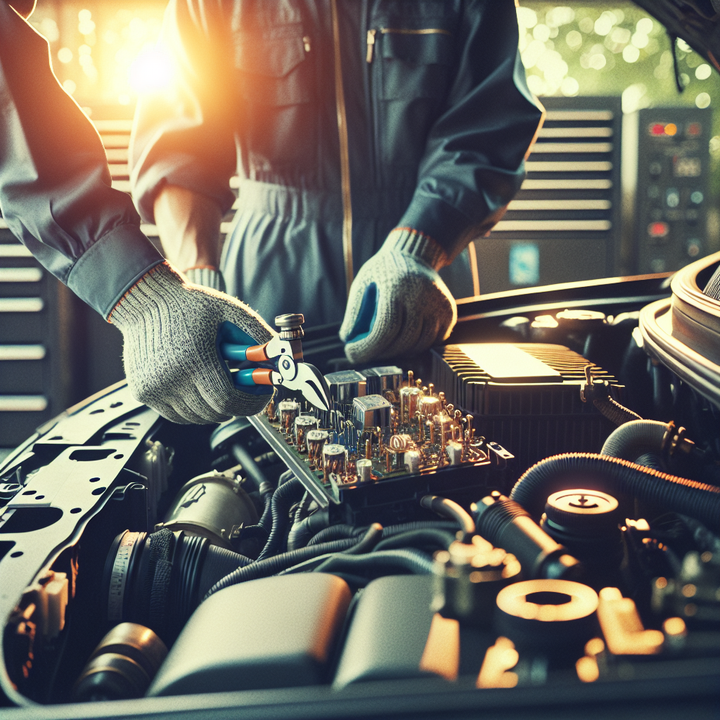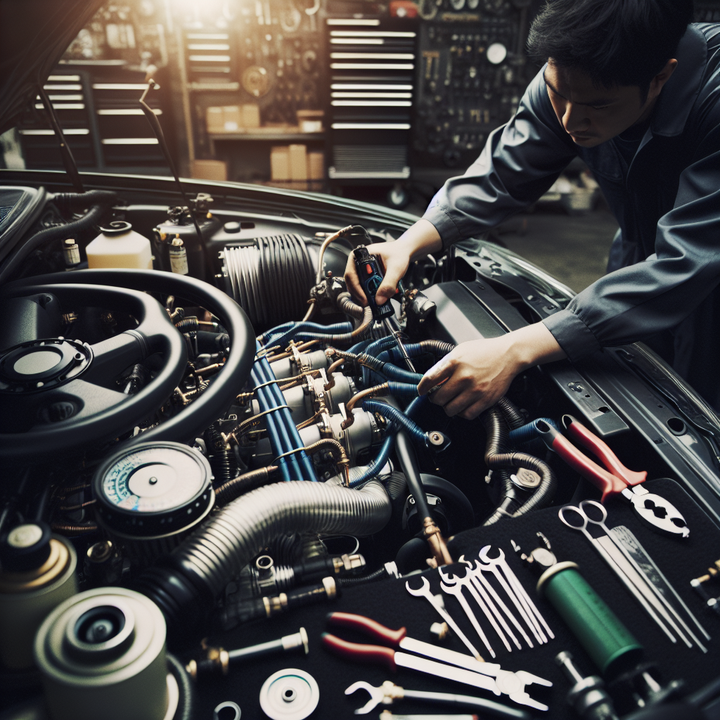


The air conditioning (AC) system in a car is designed to maintain a comfortable temperature inside the cabin by circulating refrigerant through a closed loop. This refrigerant undergoes phase changes between liquid and gaseous states, absorbing and releasing heat in the process. The low-pressure side of the AC system is responsible for allowing the refrigerant to absorb heat from the cabin air, while the high-pressure side facilitates the release of heat to the outside environment.

High low-side pressure in a car's AC system can be attributed to various factors. Here are some of the most common culprits:
| Cause | Description |
|---|---|
| Overcharged AC System | An excessive amount of refrigerant in the system can cause the low-side pressure to skyrocket, straining the entire system. |
| Faulty Compressor | A failing or damaged compressor can create an imbalance, causing high pressure on the low side and low pressure on the high side. |
| Blocked or Clogged Condenser | Restricted airflow through the condenser due to debris or a malfunctioning fan can lead to high low-side pressure. |
| Refrigerant Leaks | Leaks in the system can cause the refrigerant level to drop, prompting the compressor to work harder and increase the low-side pressure. |
| Faulty Expansion Valve or Orifice Tube | A stuck-open or missing expansion valve/orifice tube can restrict refrigerant flow, causing high low-side pressure. |
When there's too much refrigerant in the system, it can cause the low-side pressure to skyrocket. Imagine trying to squeeze too much air into a balloon – it becomes increasingly difficult and puts a strain on the entire system. Symptoms of an overcharged system may include:
Excessively high low-side pressure readings
Compressor overheating and potential failure
Reduced cooling performance
The compressor is the heart of your AC system, responsible for circulating the refrigerant. If it's failing or damaged, it can cause a peculiar situation where the low-side pressure is high, but the high-side pressure is low. It's like having a weak heart that struggles to pump blood effectively. Common signs of a faulty compressor include:
High low-side pressure, low high-side pressure
Loud noises or knocking sounds from the compressor
Reduced cooling performance
The condenser is the radiator-like component that helps dissipate heat from the refrigerant. If it's blocked by debris or has a malfunctioning fan, airflow is restricted, causing the low-side pressure to rise. Think of it as trying to breathe through a clogged straw – it becomes increasingly difficult. Symptoms of a blocked condenser may include:
High low-side pressure readings
Reduced cooling performance
Condenser fan not operating or obstructed
Leaks in the AC system can cause the refrigerant level to drop, leading to high low-side pressure as the compressor tries to compensate for the loss. It's like trying to inflate a leaky balloon – the air keeps escaping, and you have to keep pumping harder. Signs of refrigerant leaks may include:
High low-side pressure readings
Visible signs of leakage (oil residue, stains)
Reduced cooling performance over time
The expansion valve or orifice tube is responsible for regulating the flow of refrigerant into the evaporator. If it's stuck open or missing, it can restrict the flow, causing high low-side pressure. It's like having a clogged artery that restricts blood flow. Symptoms of a faulty expansion valve/orifice tube may include:

High low-side pressure readings
Reduced cooling performance
Frost buildup on the evaporator
Diagnosing the root cause of high low-side pressure in your car's AC system requires a systematic approach. Here are the steps a professional mechanic would typically follow:
Check Pressures with AC Gauges
The first step is to connect AC gauges to the service ports and check both the low and high-side pressures. By comparing the readings to the temperature pressure chart for the specific refrigerant type, you can identify if the low-side pressure is indeed too high.
Inspect the Condenser Fan and Airflow
Next, take a closer look at the condenser fan and ensure there's no debris blocking airflow. A clogged condenser can cause the low-side pressure to rise, so it's essential to keep it clean and well-ventilated.
Check for Leaks and Damage
Carefully inspect the AC components and lines for any visible leaks or damage. Even a small leak can cause the refrigerant level to drop, leading to high low-side pressure as the compressor tries to compensate.
Analyze Pressure Patterns
If you notice that the low-side pressure is high, but the high-side pressure is low, it often indicates a faulty compressor. On the other hand, if both pressures are high, the system may be overcharged with refrigerant.
Once the root cause of the high low-side pressure has been identified, the appropriate repairs can be carried out. Here are some common repair procedures:
| Repair | Description |
|---|---|
| Recover and Evacuate Excess Refrigerant | If the system is overcharged, the excess refrigerant must be recovered and evacuated to the proper level. |
| Replace Faulty Components | Faulty components like the compressor, expansion valve, or other damaged parts need to be replaced. |
| Repair Refrigerant Leaks and Recharge | Any refrigerant leaks must be repaired, and the system must be recharged with the correct amount of refrigerant and lubricant. |
| Clean or Replace Clogged Condenser and Fan | In cases where the condenser is clogged or the fan is malfunctioning, they must be cleaned or replaced to restore proper airflow. |
If the system is overcharged, the first step is to recover and evacuate the excess refrigerant to the proper level. This process should be done by a professional using specialized equipment to ensure the correct amount of refrigerant is left in the system.
If the issue is caused by a faulty compressor, expansion valve, or any other damaged component, it's essential to replace them. These parts are crucial for the proper functioning of the AC system, and attempting to repair them may only lead to temporary fixes.
If you've identified any refrigerant leaks, they must be repaired before recharging the system with the correct amount of refrigerant and lubricant. Failing to address leaks will only lead to the same issue recurring in the future.
In cases where the condenser is clogged or the fan is malfunctioning, it's necessary to clean or replace them to restore proper airflow and prevent the low-side pressure from rising again.
Preventive maintenance is key to avoiding costly repairs and ensuring the longevity of your car's AC system. Here are some essential preventive measures:
Regular Maintenance and Professional Service
Have your AC system serviced and recharged by a professional every 2-3 years.
Regular maintenance can help identify potential problems before they escalate and ensure your system is operating at peak efficiency.
Check for Leaks and Damage
During routine maintenance, have your mechanic check for any signs of leaks or damage to the AC components and lines.
Addressing these issues promptly can prevent more significant problems down the line.
Ensure Proper Airflow to the Condenser
Keeping the condenser clean and ensuring the fan is operational is crucial for maintaining proper airflow.
This simple step can go a long way in preventing high low-side pressure issues.
Follow Manufacturer's Recommendations
Always follow the manufacturer's recommended operating procedures for your vehicle's AC system.
These guidelines are designed to ensure optimal performance and longevity of the system.
The cost of repairs can vary significantly depending on the specific issue and the make/model of your vehicle. Here's a general breakdown of common repair costs:
| Repair | Approximate Cost Range |
|---|---|
| Compressor Replacement | $500 - $1,000+ (including labor) |
| System Recharge | $100 - $300 |
| Condenser Replacement | $200 - $800+ |
| Expansion Valve Replacement | $200 - $500+ |
While these repairs may seem expensive, addressing issues promptly can help prevent more costly repairs down the line. Regular maintenance and following preventive measures can also help extend the lifespan of your AC system, ultimately saving you money in the long run.
Dealing with a car air conditioning system where the low pressure is too high can be a frustrating experience, but with the right knowledge and approach, it's a problem that can be resolved. By understanding the common causes, performing proper diagnostics, and implementing the necessary repairs and preventive measures, you can ensure your AC system runs smoothly, keeping you cool and comfortable during those hot summer drives.
Remember, seeking professional assistance from a qualified mechanic is always recommended, especially when dealing with complex AC system issues. With their expertise and the right tools, they can accurately diagnose and address the root cause of the problem, ensuring a long-lasting solution.
So, the next time you notice your car's low-side pressure reading too high, don't sweat it! Armed with the knowledge from this comprehensive article, you'll be better equipped to tackle the issue head-on and enjoy a refreshingly cool ride.
Excessively high low-side pressure readings and reduced cooling performance are common signs of an overcharged AC system. The compressor may also overheat, potentially leading to failure.
A stuck-open or missing expansion valve/orifice tube can restrict refrigerant flow, causing an increase in low-side pressure as the compressor works harder to compensate.
A blocked or clogged condenser can restrict airflow, leading to an increase in low-side pressure as the refrigerant struggles to dissipate heat effectively.
Yes, leaks in the AC system can cause the refrigerant level to drop, prompting the compressor to work harder and increase the low-side pressure to compensate for the loss.
Higher ambient temperatures generally result in higher system pressures, as the refrigerant has to work harder to dissipate heat and maintain the desired cooling capacity.
The dryer's primary function is to remove moisture from the refrigerant, preventing issues like high low-side pressure caused by moisture buildup.
A failing or damaged compressor can create an imbalance, causing high pressure on the low side and low pressure on the high side as it struggles to circulate the refrigerant effectively.
Regular maintenance, including professional service and recharging every 2-3 years, is recommended to prevent issues like high low-side pressure and ensure optimal system performance.
Yes, if the evaporator coils are faulty or obstructed, they may not be able to absorb heat effectively, leading to an increase in low-side pressure as the refrigerant struggles to cool the cabin.
Repair costs can vary significantly, ranging from $100-$300 for a system recharge to $500-$1,000 or more for a compressor replacement, depending on the root cause and the make/model of the vehicle.

Sarah isn't your average gearhead. With a double major in Mechanical Engineering and Automotive Technology, she dived straight into the world of car repair. After 15 years of turning wrenches at dealerships and independent shops, Sarah joined MICDOT to share her expertise and passion for making cars run like new. Her in-depth knowledge and knack for explaining complex issues in simple terms make her a valuable asset to our team.













